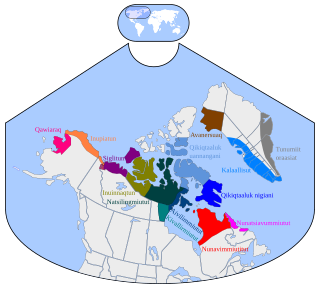
Back Uummarmiutun ET Uummarmiutun FRR Uummaġmiutun IK Ууммармиутун Russian Uummarmiut İnyupikçesi Turkish
| Uummarmiutun | |
|---|---|
| Uummaġmiutun | |
| Pronunciation | [uːm.mɑʁ.mi.u.tun] |
| Native to | Canada |
| Region | Northwest Territories |
| Ethnicity | Uummarmiut |
Eskaleut
| |
Early forms | |
| Language codes | |
| ISO 639-3 | – |
| Glottolog | None |
 Inuit dialects. Uummarmiut is the orange within Canada. | |
Uummarmiutun (Inupiaq: [uːm.mɑʁ.mi.u.tun]), Uummaġmiutun or Canadian Iñupiaq is the variant of Iñupiaq (or Inuvialuktun) spoken by the Uummarmiut, part of the Inuvialuit, who live mainly in the communities of Inuvik and Aklavik in the Northwest Territories of Canada.[1]
This dialect is essentially the same as that spoken by the Inupiat of Alaska, and is present in Canada because of migration from Alaska in the 1910s, reoccupying traditionally Siglit Inuit lands abandoned during the devastating disease outbreaks of the previous century.[2]
Because Inuvik and Aklavik are ethnically mixed communities where English is the near-exclusive language of communication, few young people speak Uummarmiutun and the language is very endangered.
It is one of the three dialects – Kangiryuarmiutun and Siglitun are the other two – of the Inuit language grouped together under the label Inuvialuktun.